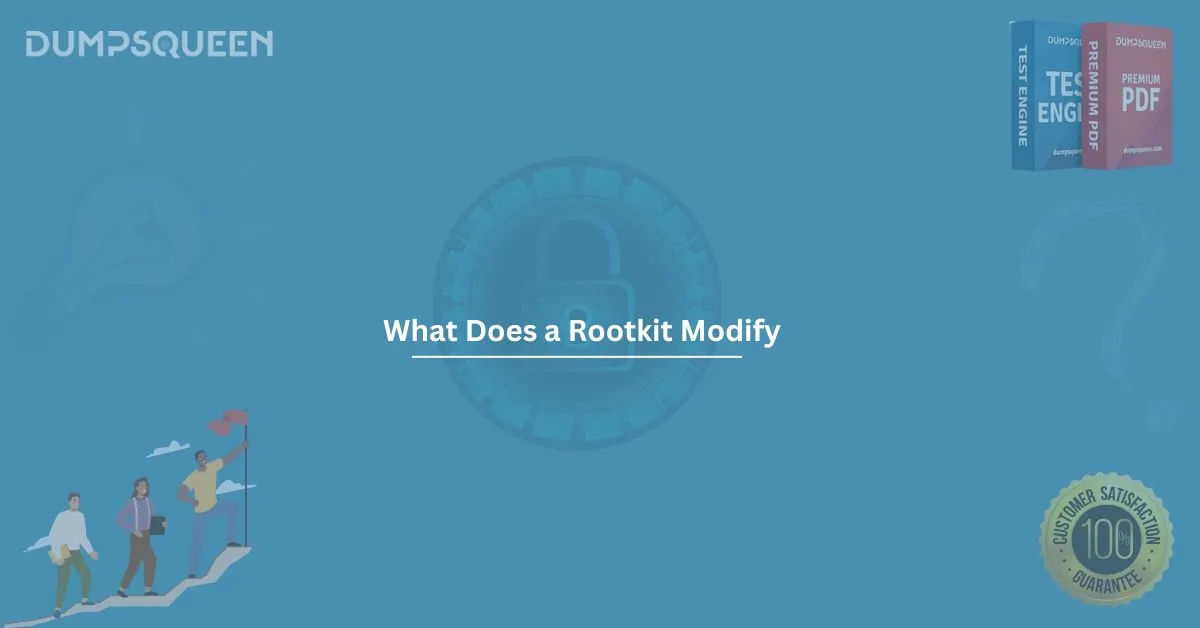Introduction
In the world of cybersecurity, threats come in many forms—viruses, trojans, spyware, and more. But among the most insidious and difficult to detect is the rootkit. As cyber threats grow more sophisticated, understanding how rootkits work and, more importantly, what does a rootkit modify becomes crucial for both IT professionals and general users.
This blog post explores the nature of rootkits, how they infiltrate systems, and the critical components they target to remain hidden. Whether you're preparing for cybersecurity certifications or seeking to enhance your defense strategies, this article is your complete guide to understanding rootkits and their destructive capabilities.
What Is a Rootkit?
A rootkit is a type of malicious software designed to gain unauthorized root or administrative-level control over a computer system. What makes a rootkit particularly dangerous is its ability to hide its presence, allowing it to operate undetected while giving attackers long-term access to the compromised machine.
Rootkits can be installed through phishing emails, malicious downloads, software vulnerabilities, or by piggybacking on legitimate applications. Once embedded, they give attackers the ability to:
- Execute files and change system configurations
- Monitor user activity
- Steal data
- Disable antivirus software
- Create backdoors for future attacks
But how do they manage all of this while staying invisible? That’s where system modification comes in.
What Does a Rootkit Modify?
1. Kernel and Operating System Functions
One of the primary targets of a rootkit is the kernel, the core of the operating system. Kernel-mode rootkits modify system-level operations to:
- Hook system calls (like file listing and process listing)
- Replace or patch kernel modules
- Alter system libraries and device drivers
By doing so, the rootkit can hide files, processes, registry keys, or network connections, making it incredibly hard to detect with traditional tools.
2. System Files and Libraries
Rootkits often alter system files such as:
- ntoskrnl.exe (Windows kernel)
- DLL files (Dynamic-Link Libraries)
- lsass.exe, winlogon.exe, or explorer.exe (key Windows processes)
Modifying these allows the rootkit to execute malicious code under the guise of legitimate system operations.
3. Boot Processes
Some rootkits, like bootkits, modify the Master Boot Record (MBR) or the UEFI/BIOS firmware. These ensure the rootkit loads before the OS, giving it full control and making removal extremely difficult without a full system wipe.
4. Security Tools and Logs
Rootkits disable or alter:
- Antivirus software
- Security scanners
- System logs
This ensures that users and administrators are not alerted about the unauthorized access. Modifying or deleting logs also makes forensic analysis nearly impossible.
5. Network Configuration and Traffic
Rootkits can tweak:
- Firewall rules
- Network routing tables
- DNS settings
This allows attackers to exfiltrate data, redirect traffic, or communicate with Command and Control (C&C) servers—all while staying under the radar.
Types of Rootkits Based on What They Modify
|
Rootkit Type |
What It Modifies |
Impact |
|
User-mode Rootkit |
System files, applications |
Alters app behavior, hides processes |
|
Kernel-mode Rootkit |
Kernel functions, device drivers |
Full OS control, hard to detect |
|
Bootkit |
Bootloader or MBR |
Loads before OS, highly persistent |
|
Firmware Rootkit |
BIOS/UEFI firmware |
Reinstalls itself after system wipe |
|
Hypervisor Rootkit |
Virtualization layer |
Controls the OS from below |
Detection Techniques
Given their stealth, detecting rootkits is challenging. However, some common detection methods include:
- Behavioral analysis: Monitoring for unusual behavior patterns
- Signature-based detection: Using antivirus databases
- Memory dump analysis: For in-depth forensic inspections
- Rootkit scanners: Tools like GMER, RootkitRevealer, or chkrootkit
- System integrity checks: Comparing current system files to known-good versions
Despite these methods, kernel and firmware rootkits are especially hard to detect without specialized tools or hardware support.
How to Remove Rootkits
- Boot into Safe Mode or use a bootable antivirus rescue disk
- Run rootkit-specific removal tools
- Perform system restore (if unaffected)
- In severe cases, reinstall the OS or replace the hard drive
- For firmware rootkits, reflashing the BIOS/UEFI may be necessary
Always remember: rootkits are designed to survive traditional removal techniques. Early detection is the best defense.
Why Understanding “What Does a Rootkit Modify” Matters
Knowing what a rootkit modifies helps:
- Cybersecurity professionals create better detection tools
- Incident response teams understand how deep the compromise goes
- Certification students (like CompTIA, CEH, CISSP) answer exam questions more accurately
- Organizations make informed decisions about mitigation and recovery strategies
Real-World Rootkit Attacks
- Sony BMG Rootkit (2005)
Sony’s DRM software installed a rootkit on user machines without consent, hiding files and leaving systems vulnerable. - TDSS/Alureon Rootkit
Modified MBR to gain deep access, often used to deliver trojans and spyware. - Stuxnet Worm
Included rootkit components to remain hidden while sabotaging Iran’s nuclear centrifuges.
Final Thoughts
Rootkits are one of the most dangerous types of malware due to their stealth and deep system access. Understanding what does a rootkit modify is critical not only for IT and cybersecurity professionals but also for users who wish to keep their systems secure.
As attackers grow more sophisticated, staying educated about threats like rootkits ensures stronger defense mechanisms. Whether you're studying for a certification or securing enterprise systems, always be vigilant for signs of rootkit activity and take proactive steps for detection and removal.
Sample Questions and Answers
Q1. What does a kernel-mode rootkit typically modify?
A. Antivirus software
B. BIOS settings
C. System calls and kernel functions
D. User application settings
Answer: C. System calls and kernel functions
Q2. Which of the following is most likely to be modified by a bootkit?
A. Application files
B. Master Boot Record (MBR)
C. Firewall settings
D. Registry keys
Answer: B. Master Boot Record (MBR)
Q3. What is the main reason rootkits modify system logs?
A. To crash the system
B. To improve performance
C. To avoid detection
D. To run faster
Answer: C. To avoid detection
Q4. What does a firmware rootkit modify to maintain persistence?
A. RAM
B. Virtual memory
C. BIOS or UEFI firmware
D. File extensions
Answer: C. BIOS or UEFI firmware




